The compressive strength of concrete is a measure of its ability to withstand axial loads or forces that tend to squeeze the material. It is typically reported in pounds per square inch (psi) or megapascals (MPa) and is determined through standardized testing. The strength depends on factors like mix proportions, curing conditions, and the quality of ingredients used in the concrete mix.
Compressive strength of concrete – cube test procedure & result at 7 days & 28 days of curing, hi guys in this article we know about compressive strength of different grade of concrete concrete at 7 days, 14 days and 28days of curing and compressive strength test of concrete cube.
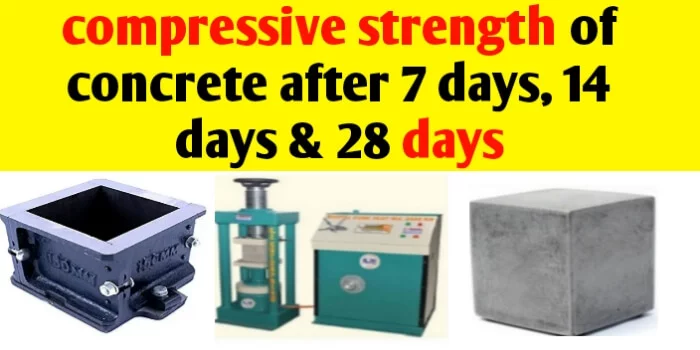
What is Compressive strength? Compressive strength is the capacity of material or structure to resist or withstand under compressive load. The Compressive strength is determined by the ability of the concrete material to resist failure in the form cracks and fissure. The maximum load at which the specimen breaks is taken as a compressive load.
The compressive strength of M30 grade concrete varies between 27 and 33 N/mm2 (i.e. between 270 kg/cm^2 and 330 kg/cm^2) after 28 days curing. This means that the concrete can withstand a compressive load of 270 to 330 kg/cm² before it fails.
The compressive strength of M25 grade concrete varies between 22 and 28 N/mm2 (i.e. between 220 kg/cm^2 and 280 kg/cm^2) after 28 days curing. This means that the concrete can withstand a compressive load of 220 to 280 kg/cm² before it fails.
The compressive strength of M15 grade concrete varies between 12 and 18 N/mm2 (i.e. between 120 kg/cm^2 and 180 kg/cm^2) after 28 days curing. This means that the concrete can withstand a compressive load of 120 to 180 kg/cm² before it fails.
The compressive strength of M20 grade concrete varies between 17 and 23 N/mm2 (i.e. between 170 kg/cm^2 and 230 kg/cm^2) after 28 days curing. This means that the concrete can withstand a compressive load of 170 to 230 kg/cm² before it fails.
In compressive strength test of concrete cube the push force applied on the both faces of concrete specimen and the maximum compression that concrete bears without failure is noted.
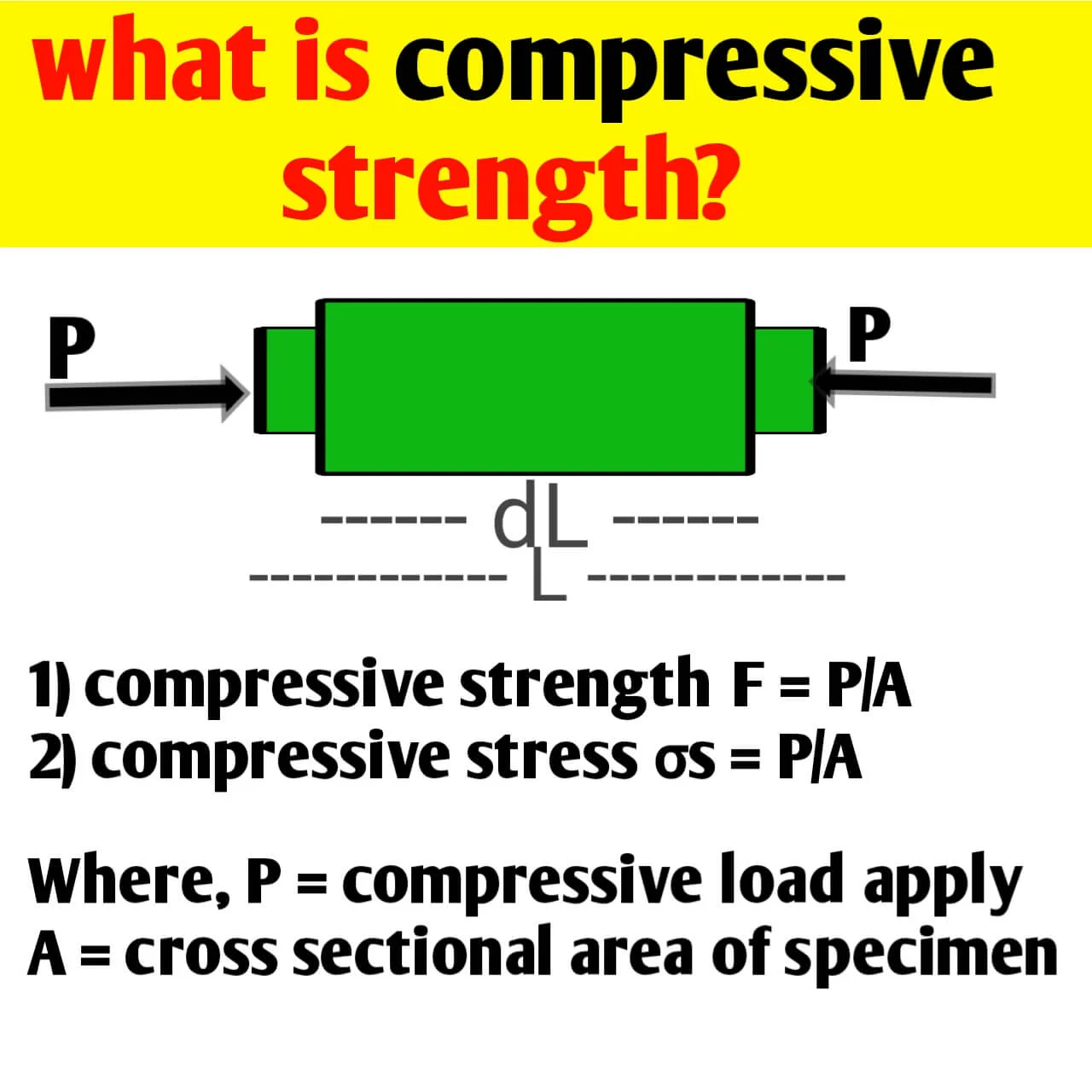
Compressive Force acting on concrete testing specimen helps us to majorly focus on the Compressive strength of concrete because it helps us to quantify the ability of concrete to resists Compressive stresses among structures where-as other stresses such as axial stresses and tensile stresses are catered by reinforcement and other means.
ALSO READ: COMPRESSIVE STRENGTH OF CEMENT
As we know compressive strength is measured by compressive strength test machine (CTM). Compressive strength is defined as ratio of compressive load applied by CTM machine on concrete cube or cylinder to cross sectional surface area of concrete cube. Compressive strength is represented by F which is equal to F = P/A, where F = compressive strength,P= total load applied by CTM machine & A = cross sectional surface area.
Compressive strength of concrete at 3,7,14 & 28 days
Generally strength of concrete measured in psi (pound force per square inch in USA) & MPa (mega pascal) in India and other country. MPa in another terms represented as N/mm2. And 1MPa = 145.038 psi.
As per IS code the cube strength achieved by the concrete in 7 days is about 65%, in 1 day is about 16%, in 3 days is about 40%, in 14 days is about 90%, in 21 days is about 94% and in 28 days is approximately 99%.
As per IS code the cube strength achieved by the M25 concrete in 7 days is about 16.24 MPa, in 1 day is about 4 MPa, in 3 days is about 10 MPa, in 14 days is about 22.5 MPa, in 21 days is about 23.5 MPa and in 28 days is approximately 25 MPa.
As per IS code the cube strength achieved by the M15 concrete in 7 days is about 9.75 MPa, in 1 day is about 2.4 MPa, in 3 days is about 4 MPa, in 14 days is about 13.5 MPa, in 21 days is about 14.1 MPa and in 28 days is approximately 15 MPa.
As per IS code the cube strength achieved by the M20 concrete in 7 days is about 13 MPa, in 1 day is about 3.2 MPa, in 3 days is about 8 MPa, in 14 days is about 18 MPa, in 21 days is about 18.8 MPa and in 28 days is approximately 20 MPa.
As per IS code the cube strength achieved by the M30 concrete in 7 days is about 19.5 MPa, in 1 day is about 4.8 MPa, in 3 days is about 12 MPa, in 14 days is about 27 MPa, in 21 days is about 28.2 MPa and in 28 days is approximately 30 MPa.
The compressive strength achieved by the concrete is about 16% of the target strength at 1 days, about 40% at 3 days, about 65% at 7 days, about 90% at 14 days, about 94% at 21 days and about 99% of the target strength at 28 days.
Generally compressive strength of concrete can vary from 2175 psi (15 MPa) to 4350 psi (30MPa) for construction of residential and commercial structure and may exceed higher upto 10000 psi (70MPa) for specified certain structure.
When compressive load acting on both face of concrete cube, it resist or withstand under compressive load and causes compression. Due to compression diameter of concrete cube structure is increased and their length is decrease and developing stress known as compressive stress.
ALSO READ: COMPRESSIVE STRENGTH OF BRICK
Compressive stress is represented by σs, which is equal to ratio of compressive load to cross sectional area of concrete cube structure,such that σs = P/A, where P = compressive load and A = cross sectional area of concrete cube specimen. Now understand with given diagram.
Compressive strength is the maximum load at which the specimen breaks is taken as a compressive load represented by F or S, which is equal to ratio of compressive load to cross sectional area of specimen,such as F=P/A, where F = compressive strength,P = compressive load and A = area of cross section of specimen.
Compressive strength of concrete at 3, 7,14 & 28 days: This strength is measured by CTM testing Standard 15cm larger & 10cm smaller cubes in India and standard cylinder specimens dai 15cm & height 30cm in USA and a few other countries.
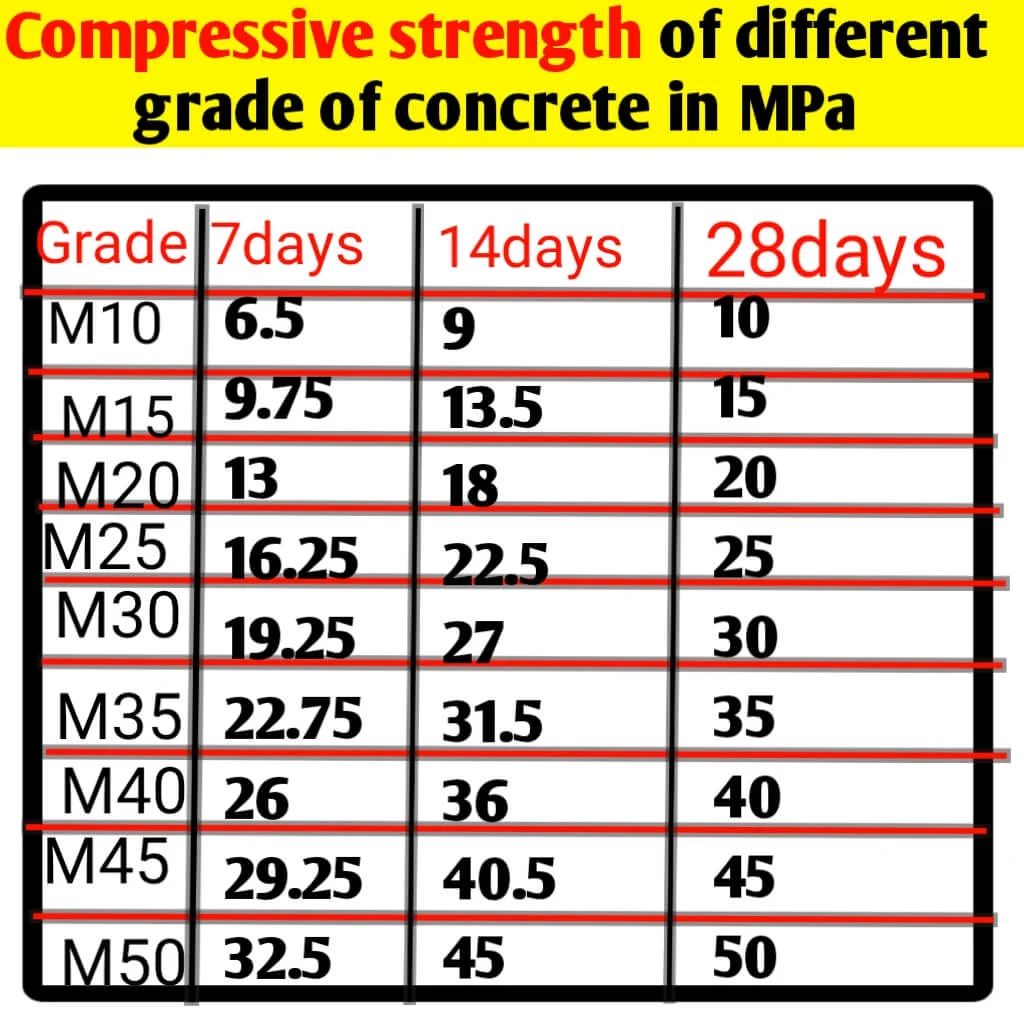
The grade of M25 concrete is denoted by the letter M or C (Europe) stand for mix & followed by numerical figure is compressive strength. Thus compressive strength of M25 concrete is 25N/mm2 (25MPa) or 3626Psi.
Compressive strength of different grade concrete at 3 days
Making of at least 3 concrete cube size each 150mm×150mm×150mm in mould by cement sand and aggregate different ratio for different grade of concrete, use tamping rod for levelling the surface of mould, it is kept for 24 hours setting after water mix in concrete, after 24 hours it is kept in water for curing for 3 days. And taken out just 30 minute prior to start of test.

Calculation: Now concrete cube test by CTM machine,assuming 14N/mm2/minute load is applied on concrete cube specimen of different grade till the cube collapse. The maximum load at which the specimen breaks is taken as a compressive load. Now following results are obtained for compressive strength of different grade of concrete at 3 days of curing given in table
Table 1: compressive strength of concrete at 3 days measured in MPa (N/mm2) or psi.
Conc. Grade MPa psi
● M10 —- 4 MPa or 580 psi
● M15 —- 6 MPa or 870 psi
● M20 —- 8 MPa or 1160 psi
● M25 —- 10 MPa or 1450 psi
● M30 —- 12 MPa or 1740 psi
● M35 —- 14 MPa or 2030 psi
● M40 —- 16 MPa or 2320 psi
● M45 —- 18 MPa or 2610 psi
● M50 —- 20 MPa or 2900 psi
Compressive strength of different grade concrete at 7 days
Making of at least 3 concrete cube size each 150mm×150mm×150mm in mould by cement sand and aggregate different ratio for different grade of concrete, use tamping rod for levelling the surface of mould, it is kept for 24 hours setting after water mix in concrete, after 24 hours it is kept in water for curing for 7 days. And taken out just 30 minute prior to start of test.
Calculation: Now concrete cube test by CTM machine,assuming 14N/mm2/minute load is applied on concrete cube specimen of different grade till the cube collapse. The maximum load at which the specimen breaks is taken as a compressive load. Now following results are obtained for compressive strength of different grade of concrete at 7 days of curing given in table
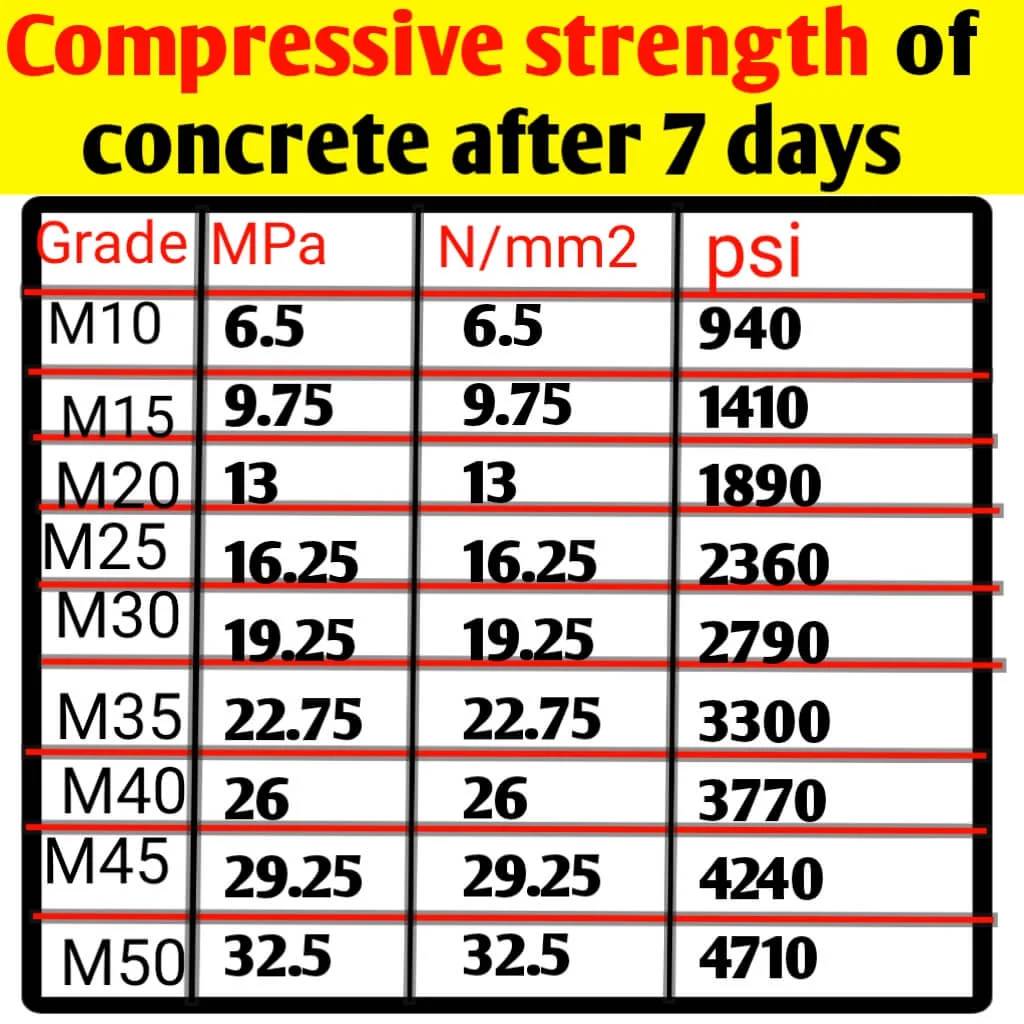
Table 2: compressive strength of concrete at 7 days measured in MPa (N/mm2) or psi.
Conc. Grade MPa psi
● M10 —- 6.5 MPa or 940 psi
● M15 —- 9.75 MPa or 1410 psi
● M20 —- 13 MPa or 1890 psi
● M25 —- 16.25 MPa or 2360 psi
● M30 —- 19.25 MPa or 2790 psi
● M35 —- 22.75 MPa or 3300 psi
● M40 —- 26 MPa or 3770 psi
● M45 —- 29.25 MPa or 4240 psi
● M50 —- 32.5 MPa or 4710 psi
Compressive strength of different grade concrete at 14 days
Now following results are obtained for compressive strength of different grade of concrete at 14 days of curing given in table
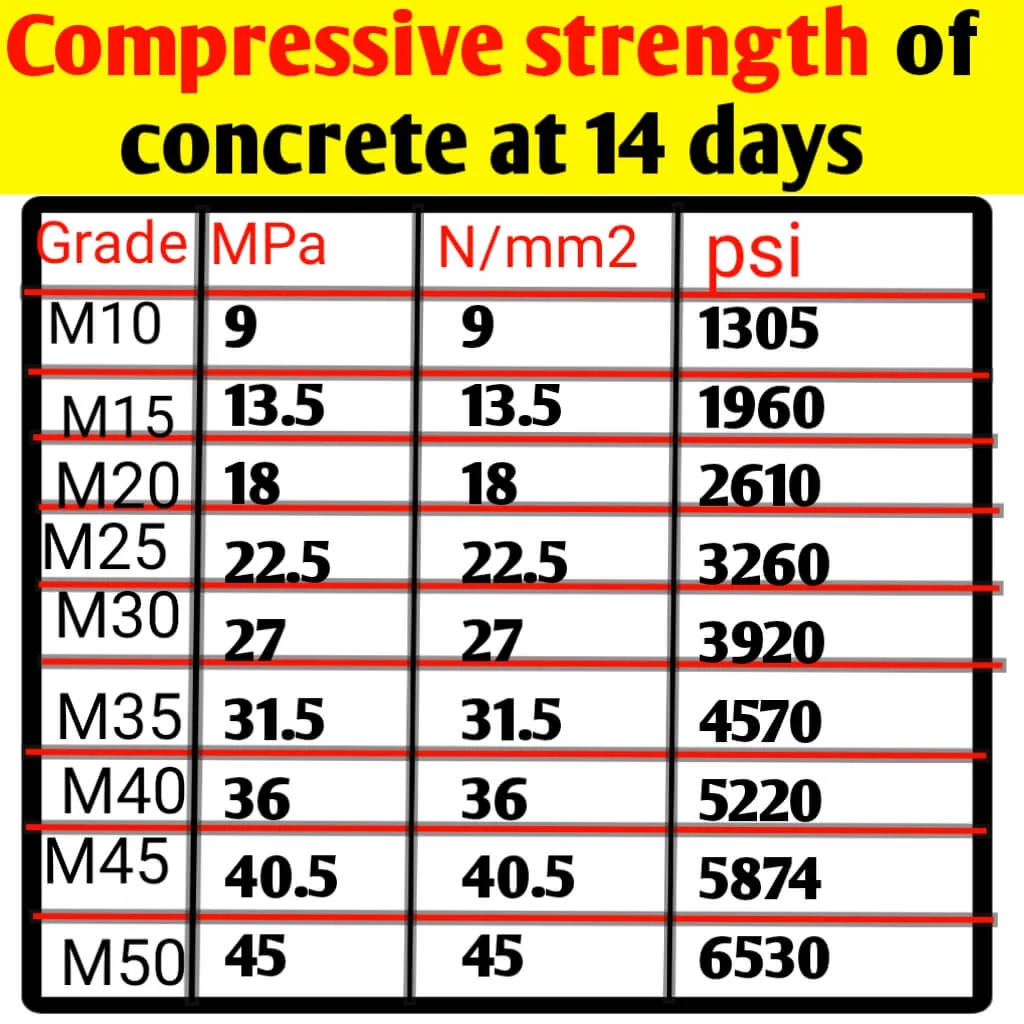
Table 3: compressive strength of concrete at 14 days measured in MPa (N/mm2) or psi.
Conc. Grade MPa psi
● M10 —- 9 MPa or 1305 psi
● M15 —- 13.5 MPa or 1960 psi
● M20 —- 18 MPa or 2610 psi
● M25 —- 22.5 MPa or 3260 psi
● M30 —- 27 MPa or 3920 psi
● M35 —- 31.5 MPa or 4570 psi
● M40 —- 36 MPa or 5220 psi
● M45 —- 40.5 MPa or 5874 psi
● M50 —- 45 MPa or 6530 psi
Compressive strength of different grade concrete at 28 days
Now following results are obtained for compressive strength of different grade of concrete at 28 days of curing given in table

Table 4: compressive strength of concrete at 28 days measured in MPa (N/mm2) or psi.
Conc. Grade MPa psi
● M10 —- 10 MPa or 1450 psi
● M15 —- 15 MPa or 2175 psi
● M20 —- 20 MPa or 2900 psi
● M25 —- 25 MPa or 3625 psi
● M30 —- 30 MPa or 4350 psi
● M35 —- 35 MPa or 5080 psi
● M40 —- 40 MPa or 5800 psi
● M45 —- 45 MPa or 6530 psi
● M50 —- 50 MPa or 7250 psi
% of concrete compressive strength over time
Relationship between concrete strength according to time is not linear, it means increasing strength is not increases according to applied load as time increases,it will increase in nonlinear.
Concrete is a macro content with Sand, Cement, & Coarse aggregate as its micro-ingredient (Mix Ratio) and gains its 100% strength over time at the hardened state.
Concrete gains 16 % of its initial strength within 24 hrs, whereas concrete gains 65% of the target strength by the time of 7 days of its casting and curing.
Till 14 days concrete shows 90% of the target strength and there after the gain in strength slows down and it takes 28 days to achieve 99% of its strength.
We cant judge the strength of concrete until it becomes stable. And we also won’t wait for 28 days to judge the concrete whether it suitable for construction or not to keep it balanced, concrete is tested at various intervals.
Table 5:- % of concrete compressive strength over time
Days % of Strength
● 1 Days — 16%
● 3 Days —- 40%
● 7 Days —— 65%
● 14 Days — 90%
● 21 Days — 94%
● 28 Days — 99%
The maximum strength gain spike is observed till 14 days, so we test concrete at an intervals of 7 days, 10 days & 14days and If concrete fails to show results of 90% of its overall strength 14 days then that batching is rejected.
Compressive strength of M20 concrete at 7 days, 14 days and 28 days
The compressive strength of M20 concrete is approximately 8 MPa (1160 psi, or 80 kg/cm^2) at 3 days, approximately 13 MPa (1900 psi, or 130 kg/cm^2) at 7 days, approximately 18 MPa (2600 psi, or 180 kg/cm^2) at 14 days, and approximately 20 MPa (2900 psi, 200 kg/cm^2) at 28 days.
Compressive strength of M10 concrete at 7 days, 14 days and 28 days
The compressive strength of M10 concrete is approximately 4 MPa (580 psi, or 40 kg/cm^2) at 3 days, approximately 6.5 MPa (940 psi, or 65 kg/cm^2) at 7 days, approximately 9 MPa (1305 psi, or 90 kg/cm^2) at 14 days, and approximately 10 MPa (1450 psi, or 100 kg/cm^2) at 28 days.
Compressive strength of M15 concrete at 7 days, 14 days and 28 days
The compressive strength of M15 concrete is approximately 6 MPa (870 psi, or 60 kg/cm^2) at 3 days, approximately 9.75 MPa (1410 psi, or 98 kg/cm^2) at 7 days, approximately 13.5 MPa (1960 psi, or 135 kg/cm^2) at 14 days, and approximately 15 MPa (2175 psi, or 150 kg/cm^2) at 28 days.
Compressive strength of M25 concrete at 7 days, 14 days and 28 days
The compressive strength of M25 concrete is approximately 10 MPa (1450 psi, or 100 kg/cm^2) at 3 days, approximately 16.25 MPa (2360 psi, or 162 kg/cm^2) at 7 days, approximately 23.5 MPa (3260 psi, or 235 kg/cm^2) at 14 days, and approximately 25 MPa (3625 psi, or 250 kg/cm^2) at 28 days.
Compressive strength of M30 concrete at 7 days, 14 days and 28 days
The compressive strength of M30 concrete is approximately 12 MPa (1740 psi, or 120 kg/cm^2) at 3 days, approximately 19.25 MPa (2790 psi, or 193 kg/cm^2) at 7 days, approximately 27 MPa (3920 psi, or 270 kg/cm^2) at 14 days, and approximately 30 MPa (4350 psi, or 300 kg/cm^2) at 28 days.
Compressive strength of Concrete and its importance
As we all know that concrete is a mixture of sand, cement, and aggregate. The strength of the concrete depends upon many factors like individual compressive strength of its constituents (Cement, Sand, aggregate), quality of materials used, air entrainment mix proportions, water-cement ratio, curing methods and temperature effects.
Compressive strength gives an idea of the overall strength and above-mentioned factors. Through conducting this test, one can easily judge the concrete strength psi and quality of concrete produced.
Factors affecting compressive strength of concrete
● Coarse aggregate:- Concrete is made homogenous by combining aggregates, cement, sand, water and various other admixtures. But even with proper mixing, there may arise some microcracks due to differences in thermal and mechanical properties of coarse aggregates and cement matrix, which leads to failure of concrete.
Concrete technologists came up with theoretical concepts regarding size of aggregates, which as the size of aggregate being the major contributor of compressive strength. So if the size of aggregate is increased, then it would lead increased compressive strength.
This theory was later discarded, as experiments proved that greater size of aggregates showed increased strength in initial phases but reduced exponentially.
The sole reason for this strength drop was due to the reduced surface area for bond strength between cement matrix and aggregates and weaker transition zone.
● Air-entrainment:- Air entrainment in concrete was one of the concepts developed by cold countries in order to prevent damages due to freezing and thawing. Later on, as experimentation’s proved multidimensional benefits of air entrainment along with improved the workability of concrete at lower water/cement ratio.
As the achievement of the desired workability at lower water content helped one to achieve concrete with the greater compressive strength which in turn, leads to light concrete with greater compressive strength.
● Water/Cement ratio:- We are all very aware of how excess water can be harmful to the strength of concrete. Cement being the major binding material in concrete needs water for hydration process, but that is only limited to about (0.20 to 0.25) % of cement content. The excess water turns out to be beneficial in contributing to workability and finishing of concrete.
The very aspect where excess water is considered harmful because as the water in the concrete matrix dries, it leaves large interstitial spaces among aggregate and cement grains. This interstitial space becomes primary cracks during compressive strength testing of concrete.
Why do we test concrete for 7 days, 14 days & 28 days?
Concrete gains maximum strength at 28days. Since in construction sector great amount of capital is at stake, so instead of checking strength at 28 days we can check strength in terms of concrete strength psi at 7 and 14 days to predict the target strength of construction work.
From the below table it is clear that, Concrete gains 16 % of its strength within 24 hrs, whereas concrete gains 65% of the target strength by the time of 7 days of its casting.
Till 14 days concrete shows 90% of the target strength and thereafter the gain in strength slows down and it takes 28days to achieve 99% of strength.
We cant judge the strength of concrete until it becomes stable. And we also won’t wait for 28 days to judge the concrete whether it suitable for construction or not to keep it balanced, concrete is tested at various intervals.
As you can see the concrete gains its strength rapidly till 7th & 14th Days upto 90% after curing, then gradually increases from there. So we can’t predict the strength until the concrete comes to that stable state.
Once it attains certain strength at 7 days, then we know (according to the table) only 9% of strength going to increase. So at sites, we do normally test concrete at this interval. If the concrete fails at 14 days, then we will reject that batching.
Compressive strength of concrete cube test Procedure & result
Concrete cube test Apparatus for procedure and result completed in following steps:
● 1) IS code:- this concrete cube test it is completed according to IS code 516
● 2) Required Equipment & Apparatus:
a) Tamping rod:- tamping rod is used for levelling the surface of concrete cube mould, it is 16mm Dia and 60cm in length.
b) CTM machine : CTM machine is required for load applying on concrete cube mould, it should be apply minimum load of 14N/mm2/minute.

c) THREE type of mould: there is two size of concrete cube mould is used for test, first is larger size of 150mm or 15cm have specific dimension (l×b×h) is 150mm×150mm×150mm with aggregate size is 38 mm and second smaller size concrete cube mould size is 100mm×100mm×100mm with aggregate size 19mm used in India.
In USA and other country cylindrical concrete mould is also used have dia 150mm, height 300mm & aggregate size is 38mm.
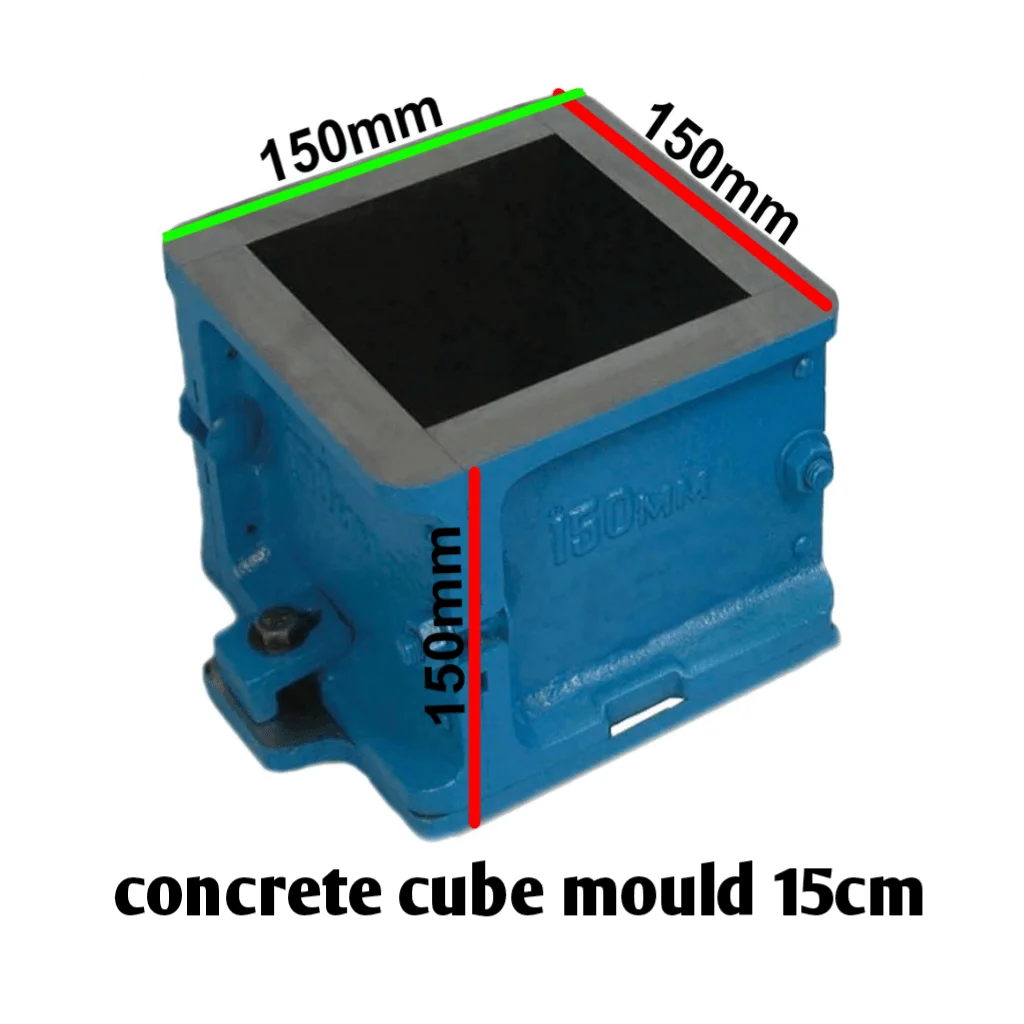
d) other Apparatus is G.I Sheet (For Making Concrete),Vibrating Needle, tray & other tools.
● 3) Environmental factors:- for standard calculation of compressive strength of concrete environmental factors should be optimum, minimum number of test specimen should be 3, temperature should be 27± 2℃ and humidity is 90%
Compressive strength test of concrete cube procedure
a) Measure the dry proportion of ingredients (Cement, Sand & Coarse Aggregate) in ratio as per the desine of concrete. The Ingredients should be sufficient enough to cast test cubes.
b) first mix cement and sand till it got uniform colour then added aggregate in it, thoroughly mix the dry ingredients to obtain the uniform colour of mixture and Add design quantity of water to the dry proportion (water-cement ratio) and mix well to obtain uniform texture
c) Fill the concrete to the mould with the help of vibrator and used tamping rod for thorough compaction and levelling the surface of concrete cube mould,Finish the top of the concrete by trowel & tapped well till the cement slurry comes to the top of the cubes.
d) After some time the mould should be covered with red gunny bag and put undisturbed for 24 hours at a temperature of 27± 2℃,After 24 hours remove the specimen from the mould.
e) Keep the specimen submerged under fresh water at 27± 2℃ for curing, the specimen should be kept for 7,14 or 28 days. Every 7 days the water should be renewed. The specimen should be removed from the water 30 minutes prior to the testing and the specimen should be in dry condition before conducting the testing.
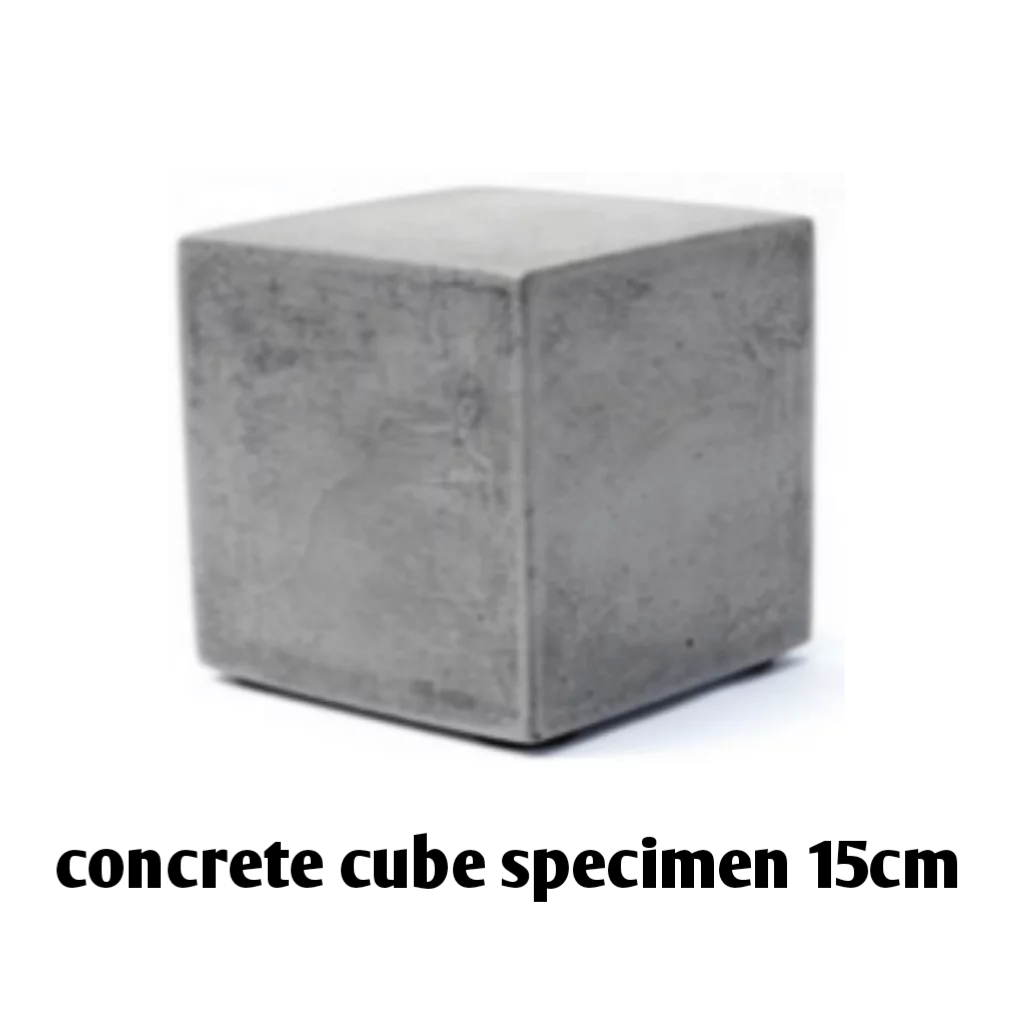
● 5) Testing of concrete cube: Now place the concrete cubes into the (CTM) testing machine at centre. The cubes should be placed correctly on the machine plate (check the circle marks on the machine). Carefully align the specimen with the spherically seated plate. The load will be applied to the specimen axially.
Now slowly apply the load at the rate of 14N/mm2/minute till the cube collapse.
The maximum load at which the specimen breaks is taken as a compressive load.
● 6) Calculation:
Compressive Strength of concrete = Maximum compressive load / Cross Sectional Area, cross sectional Area = 150mm X 150mm = 22500mm2 or 225 cm2, assume the compression load is 563 KN, then
Compressive Strength of M25 concrete after 28 days = (563N/22500mm2= 25N/mm2 (20MPa) or 3626 Psi.
◆You Can Follow me on Facebook and Subscribe our Youtube Channel
You should also visits:-
1)what is concrete and its types and properties
2) concrete quantity calculation for staircase and its formula
Conclusions:-
The compressive strength achieved by the concrete is about 65% of the target strength at 7 days, about 90% at 14 days and about 99% of the target strength at 28 days. So, The compressive strength of M20 concrete is approximately 13 MPa (1900 psi) at 7 days, approximately 18 MPa (2600 psi) at 14 days, and approximately 20 MPa (2900 psi) at 28 days.
FROM WHICH CODE IS TABLE TAKEN??
What Is the Compressive Strength of concrete?